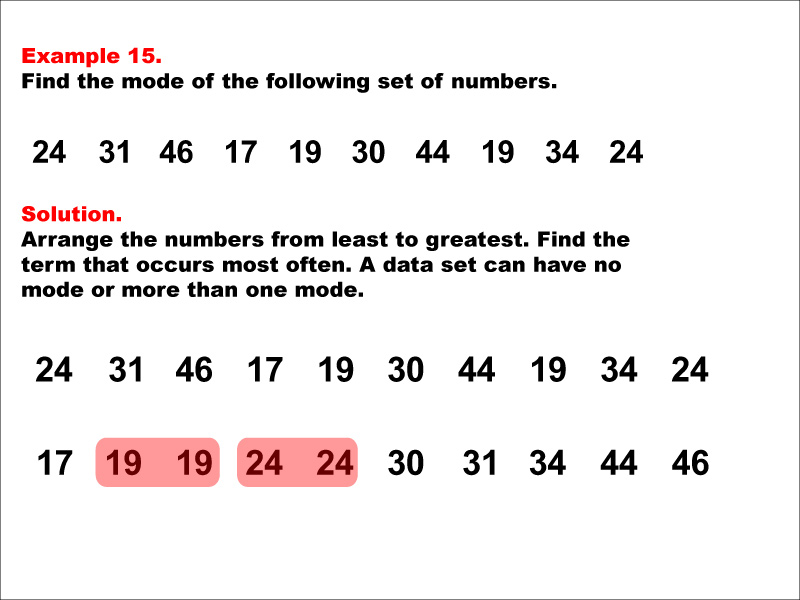
Display Title
Math Example--Measures of Central Tendency--Mode: Example 15
Display Title
Math Example--Measures of Central Tendency--Mode: Example 15

Topic
Measures of Central Tendency
Description
This example showcases a situation of measures of central tendency, where the goal is to identify a key summary measure in a set of data. The image displays a set of numbers with instructions to find the mode. Numbers are arranged in order with modes highlighted as 19 and 24. This example illustrates that a data set can have more than one mode, which occurs when two or more numbers appear with the highest frequency.
Measures of Central Tendency lessons are instrumental in providing students with a better understanding of how to interpret data through these examples. Each example highlights distinct scenarios which reinforce the concept of determining frequency of occurrences within given sets, enhancing students' analytical skills.
Seeing multiple worked-out examples is crucial in solidifying a student's grasp on a concept. Each example contributes unique perspectives and challenges that can arise when thinking about data sets. This varied approach not only caters to diverse learning styles but also ensures that all students can see the relevance of these concepts in their learning journey.
Teacher's Script
In this example, we're presented with the following set of numbers: 24, 31, 46, 17, 19, 30, 44, 19, 34, and 24. Our task is to find the mode. Remember, the mode is the value that appears most frequently in a data set. Let's start by arranging these numbers from least to greatest. Now, look carefully at our sorted list. Do you notice any numbers that appear more than once? Excellent observation! Both 19 and 24 appear twice, while all other numbers appear only once. This means our data set has two modes: 19 and 24. This situation is called a bimodal distribution. In real-world data, having two modes could indicate two distinct groups or trends within our data. For example, if these were ages of people attending a community event, it might suggest that the event was particularly popular among two different age groups.
For a complete collection of math examples related to Measures of Central Tendency click on this link: Math Examples: Measures of Central Tendency: Mode Collection.
| Common Core Standards | CCSS.MATH.CONTENT.6.SP.B.4, CCSS.MATH.CONTENT.6.SP.A.3, CCSS.MATH.CONTENT.HSS.ID.A.2, CCSS.MATH.CONTENT.HSS.ID.A.3 |
|---|---|
| Grade Range | 6 - 12 |
| Curriculum Nodes |
Algebra • Probability and Data Analysis • Data Analysis |
| Copyright Year | 2014 |
| Keywords | data analysis, tutorials, measures of central tendency, mode, average |